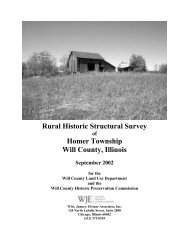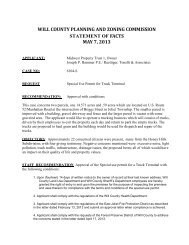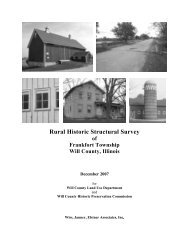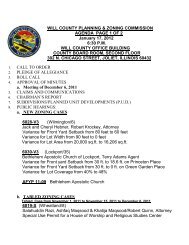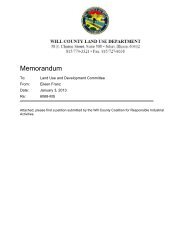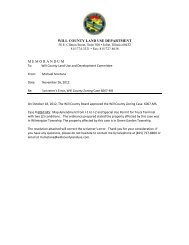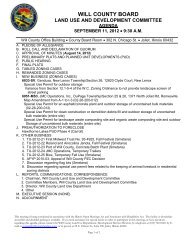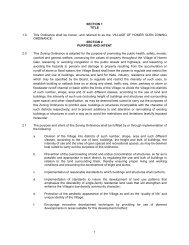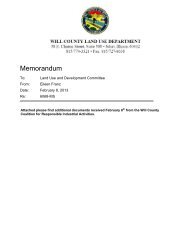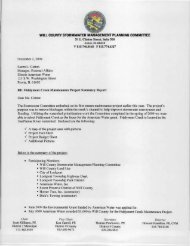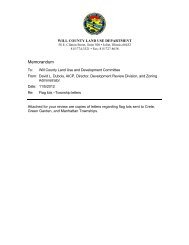Rural Historic Structural Survey - Will County Land Use
Rural Historic Structural Survey - Will County Land Use
Rural Historic Structural Survey - Will County Land Use
You also want an ePaper? Increase the reach of your titles
YUMPU automatically turns print PDFs into web optimized ePapers that Google loves.
Wiss, Janney, Elstner Associates, Inc.<br />
Agricultural Development of the State and <strong>County</strong><br />
In the late 1840s, the United States still owned 14,060,308 acres of land in Illinois. Between 1848 and<br />
1857, much of this land passed into private hands. In addition to land that could be purchased from the<br />
government, alternate five mile sections each side of the route planned for the Illinois and Michigan<br />
Canal in western <strong>Will</strong> <strong>County</strong> were offered for sale by the canal authority. Later, alternate six mile<br />
sections each side of the route granted to the Illinois Central Railroad (which passed through eastern <strong>Will</strong><br />
<strong>County</strong>) was available for purchase from the railroad. 51<br />
Another attempt was made as establishing a state agriculture organization, with the founding of the Union<br />
Agricultural Society in 1839. The organization existed the state legislature passed an act on 8 February<br />
1853 to incorporate the Illinois State Agricultural Society to promote agricultural, horticultural, and<br />
household arts. The society sponsored a State Fair annually between 1853 and 1871 at different places<br />
around the state, including at Chicago on four occasions. 52 <strong>Will</strong> <strong>County</strong> had a local chapter of the Illinois<br />
State Agricultural Society, although it remained active only intermittently and was not a strong voice in<br />
the organization. In 1871, the Department of Agriculture was formed with business conducted by a “State<br />
Board of Agriculture.” 53<br />
Illinois’ corn production was 57.65 million bushels in 1850, which increased to 115.2 million in 1860,<br />
making it the leading corn producer in the nation. 54 Wheat was also a major crop—the state was fifth in<br />
wheat production in 1850 and first in 1860. 55 Acreage in improved farmland increased two and one half<br />
Avenue, Black Road, and Ruby Street. A third toll house was located in Plainfield at Lockport Road and Van Dyke<br />
Road. Twenty years later a similar radial route around the outlying Chicago area was followed in the alignment of<br />
the Elgin, Joliet, and Eastern Railroad.<br />
51 The lands were sold to actual settlers and speculators. It is estimated that six million acres passed into the hands of<br />
speculators between 1849 and 1856. There were several types of speculators. Small farmers bought the land for<br />
pasturage, timber, or simply as an investment. Small businessmen also bought land as an investment, and in this<br />
group was included practically every prominent politician in Illinois except Abraham Lincoln. Professional<br />
speculators operated on a large scale, with corporations or individuals owning land in many states. Finally, East<br />
Coast capitalists who invested in western lands—Samuel Allerton, a wealthy resident of New York, owned 2,000<br />
acres in Frankfort, New Lenox, and Homer Townships in <strong>Will</strong> <strong>County</strong> and an additional 400 acres in Cook <strong>County</strong>.<br />
In time, settlers purchased the land from speculators. The Chicago <strong>Land</strong> Office was the last one in the state opened<br />
and the last one closed, except for Springfield, which took over all the unfinished work of all offices and remained<br />
open until 1877. (Shaw, <strong>Will</strong> <strong>County</strong> Agriculture, 1–2.)<br />
52 History of State Departments, Illinois Government, 1787–1943, compiled by Margaret C. Norton, Illinois State<br />
Archives.<br />
53 Illinois Laws 1871–1872.<br />
54 “Corn” was the term used in the Old World to what was later known as wheat to settlers in the New World.<br />
Settlers given “Indian corn” by the Native Americans began to sow it themselves, with corn becoming one of the<br />
leading grain crops by the 1800s. Farmers were cognizant of the numerous factors that led to a successful corn crop,<br />
including planting time, soil treatments, and pest prevention. In Illinois, the Illinois Corn Breeders association was<br />
founded in 1890 to disseminate information and develop better seed stock. Beginning in the 1920s, the University of<br />
Illinois began studies that led to improvements in corn varieties. In Illinois alone, sixteen breeds were reported in<br />
1936, one of which was called “<strong>Will</strong> <strong>County</strong> Favorite.” (United States Department of Agriculture, Yearbook of<br />
Agriculture (1936), 496.)<br />
55 Wheat was one of the earliest crops sown by settlers in the New World. The process of developing hybrid strains<br />
of wheat was initiated by individuals and educational institutions before this work was addressed by the U.S.<br />
Department of Agriculture and state agricultural experiment stations. Numerous other grains grown historically in<br />
<strong>Will</strong> <strong>County</strong>, including oats and barley, benefited from hybrid research conducted by university and governmental<br />
agriculture studies. The first Agriculture administrative body in the United States was in New York, where a State<br />
Board of Agriculture was established in 1819. The U.S. Department of Agriculture was established in 1862, and was<br />
raised to cabinet status in 1880. State agricultural experiment stations, operated by the U.S. Department of<br />
Agriculture, were established in 1887.<br />
<strong>Will</strong> <strong>County</strong> <strong>Rural</strong> <strong>Historic</strong> <strong>Structural</strong> <strong>Survey</strong><br />
Du Page Township Chapter I – 23



